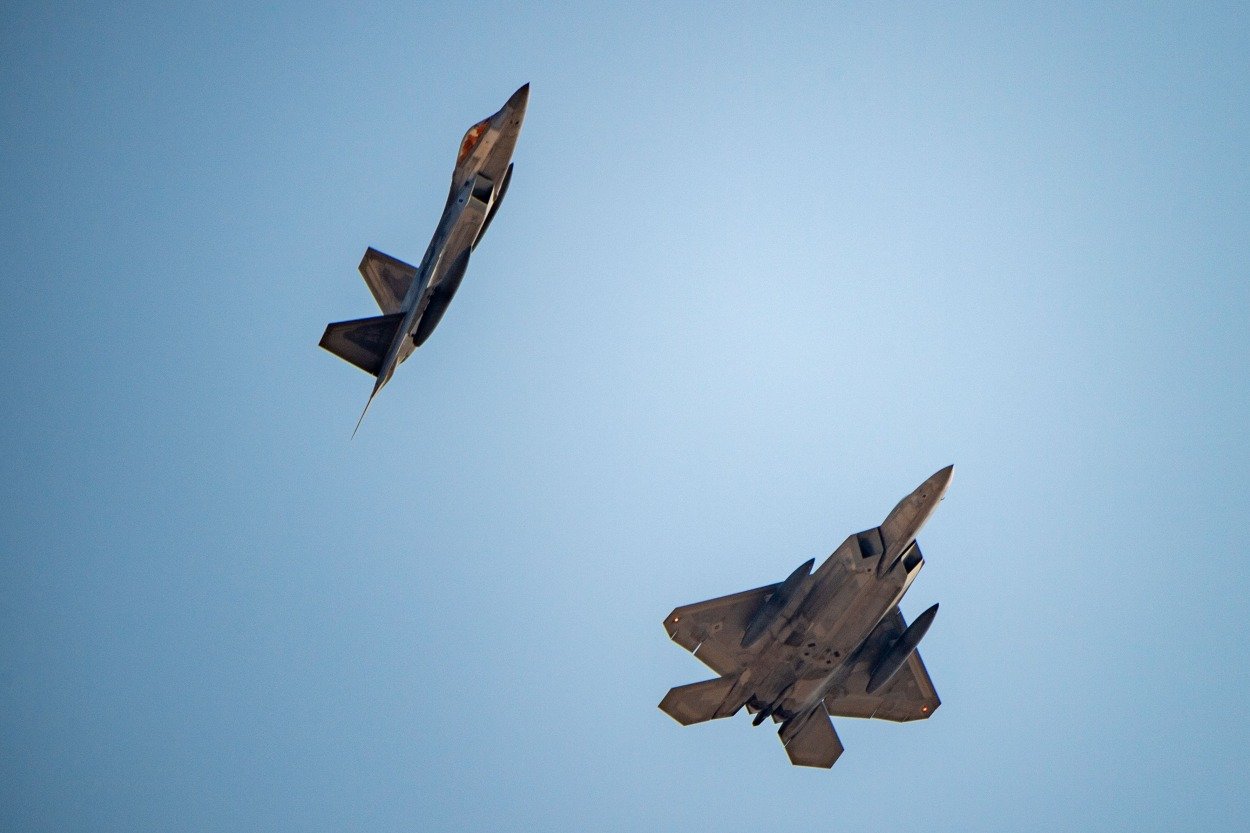As the threat of an all-out Iranian attack on Israel looms large, the United States has sprung into action and deployed its best war machines to the Middle East: the F/A-18 Super Hornets and the F-22 Raptor stealth aircraft. Now, they await action.
Reports indicate that the F/A-18 Super Hornets from the US Navy, which took off from the aircraft carrier USS Theodore Roosevelt, are currently carrying out operations from an air base in Jordan.
Although the “Fist of the Fleet” Strike Fighter Squadron 25 (VFA-25) sent the F/A-18Es to the USAF’s 332nd Air Expeditionary Wing in early August, the US Air Force (USAF) only recently released the images.
Even though the service did not name the base in its official communication, experts and Open Source Intelligence (OSINT) analysts identified that the aircraft had been stationed at Muwaffaq Al-Salti Air Base in Jordan. Earlier, the aircraft was believed to be headed to an unknown base, as recently reported by EurAsian Times.
The photographs depict the aircraft ready to carry out counter-air operations, as the fighters are equipped with four live AIM-120 Advanced Medium-Range Air-to-Air Missiles (AMRAAM) and four AIM-9X Sidewinders.
The F/A-18 Super Hornets were previously deployed to the region to shoot down missiles fired from Yemen-based Houthi militia in the wake of Israel’s bombing campaign in Gaza. Several starfighters were observed with markings of the US Navy’s F/A-18E/F Super Hornets, deployed aboard the supercarrier USS Dwight D. Eisenhower ‘Ike’ in the Gulf of Aden.
“undisclosed location” https://t.co/NI9ECYbdrf – US Navy VFA-25 F/A-18 Super Hornet at Azraq/Muwaffaq Salti Air Base, Jordan https://t.co/e9F9hd8ApQ pic.twitter.com/66wBnUxX1M
— Samir (@obretix) August 8, 2024
The Super Hornets also conducted multiple strikes against the Houthis along with their British counterparts. In January, for example, the F/A-18s from the USS Eisenhower and other ships shot down two anti-ship cruise missiles, a ballistic missile fired by the Houthis, and 18 drones during one firefight.
The forward deployment of these assets in Jordan is a component of a United States strategy aimed at intercepting missiles and drones launched by Iran and its affiliates before they reach Israeli territory. The US already has the F-15E Strike Eagle, the F-16 Fighting Falcons, and the A-10 Warthogs deployed to the US Central Command (CENTCOM).

In addition to the Super Hornets, the fifth-generation war machines of the USAF, the F-22 Raptors have reportedly taken up positions in the region—albeit at an unknown base. CENTCOM announced on August 8 the arrival of F-22 fighter jets in its area of responsibility without naming the location owing to operational security reasons.
The F-22 Raptors are “part of U.S. force posture changes in the region to mitigate the possibility of regional escalation by Iran or its proxies,” the Command said in a statement.
U.S. Air Force F-22 Raptors arrived in the U.S. Central Command area of responsibility Aug. 8 as part of U.S. force posture changes in the region to mitigate the possibility of regional escalation by Iran or its proxies. pic.twitter.com/BuuzbUHu9s
— U.S. Central Command (@CENTCOM) August 8, 2024
About 12 F-22s from Joint Base Elmendorf-Richardson, Alaska, arrived at a base in the Middle East. The F-22s went almost 5,600 nautical miles, passing across North America and the Atlantic Ocean, stopping at RAF Lakenheath in the United Kingdom, and traversing the Mediterranean Sea. On August 8, with the assistance of tanker aircraft, they arrived at their new, unknown residence in the region.
The F-22 Raptor is the Air Force’s top-tier fifth-generation fighter aircraft. As for the F-22s’ deployment to the Middle East, Deputy Pentagon Press Secretary Sabrina Singh stated, “They can be a very invaluable defensive platform. They add maneuverability [and] additional systems that allow the commander to have more versatile options. And I think it sends a very clear signal to the region that we want to see tensions de-escalate. And it sends a really powerful message of deterrence.”
Unlike the Super Hornet, the F-22 Raptor has had just one combat kill to its credit: shooting down of a Chinese surveillance balloon. Nonetheless, the deployment of a stealthy aircraft with Raptor’s advanced sensors and super-maneuverability is expected to boost Israel’s defense as a crisis looms large.

Iran’s Attack Imminent?
Following the deaths of the senior political leader of Hamas, Ismail Haniyeh, in Tehran, and top Hezbollah commander, Fouad Shukur, in Beirut, last week, concerns have been voiced that Iranian retribution might ignite a wider regional conflict beyond Israel’s fight with Hamas. Israel is believed to be behind both killings after months of bloody attacks on Gaza, which have resulted in nearly 40,000 Palestinian deaths.
Earlier, Nasser Kanaani, a spokesman for the Iran Ministry of Foreign Affairs, stated that the only way to bring about regional security is to “punish the aggressor and create deterrence against the adventurism of the Zionist regime [Israel]”. Iran is expected to be joined by Hezbollah, which has also vowed vengeance after the killing of its top commander.
While bracing for such a multi-pronged attack, Israel’s chief ally, the US, is also using all its available tools to coerce Iran into not launching the strike at all.
Reports indicate that the US has cautioned Iran that launching a retaliatory strike against Israel could place Iran’s economy and government in “serious jeopardy” and likely escalate the ongoing conflict between Israel and Hamas, which has persisted for several months.
American officials told The Wall Street Journal that Iran has been informed about an “extremely high” risk of a significant escalation should it launch a retaliatory attack. According to an unknown official cited by the publication, Tehran has been warned that “if it goes down that path, there is a serious risk of consequences for Iran’s economy and the stability of its newly elected government.”
Various reports indicate that Iran has been urged to reconsider its plans for an attack despite earlier warnings. According to US officials speaking to Politico, Iran might be reassessing its intention to execute a significant offensive against Israel.
However, Iranian officials have made no such assertion, and observers believe an attack is imminent.





